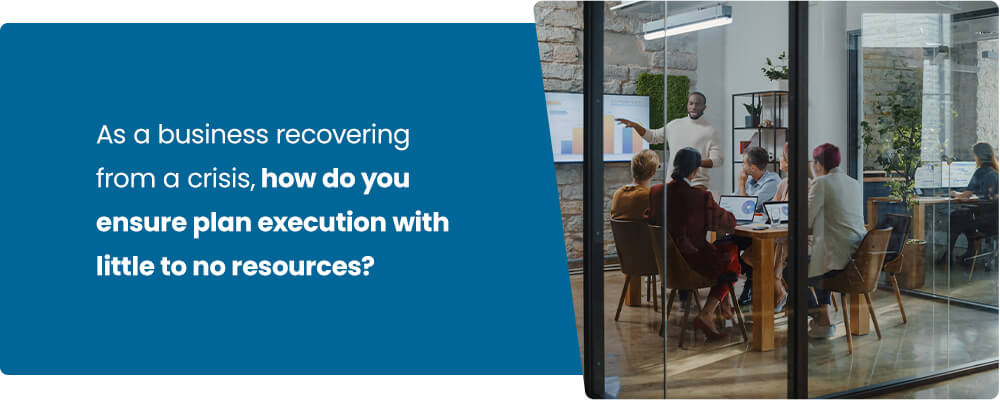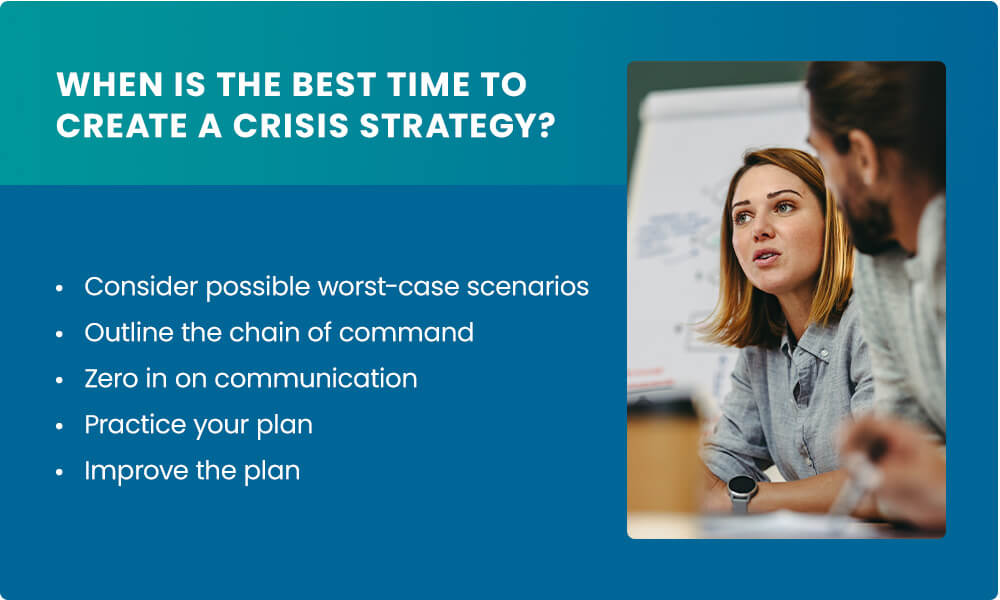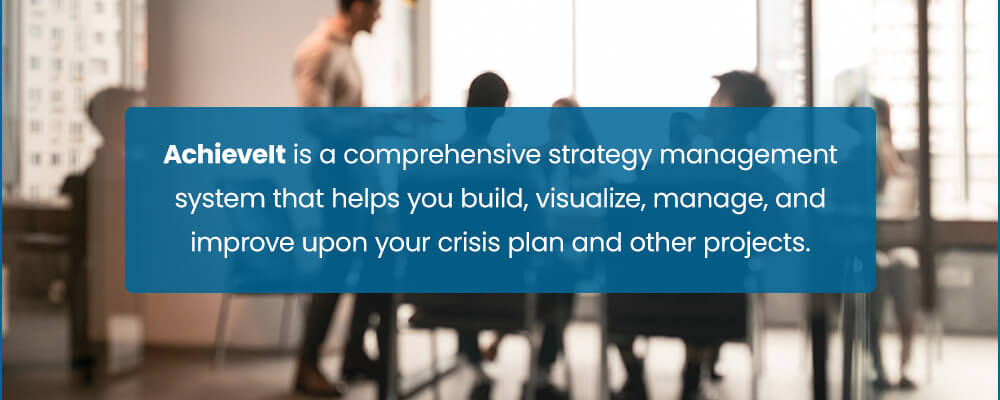If 2020 and the COVID-19 pandemic taught businesses anything, it was to expect the unexpected. COVID-19 disrupted businesses in every industry and of every size, bringing many strategic plans to a screeching halt as efforts were redirected to managing the crisis. The pandemic is a prime example of the effects a crisis can have on a business, but a crisis can be any unexpected event that makes an organization unstable.
While you can’t anticipate every potential situation that might come your way, you can strategically plan for a crisis. A strong strategic plan can help you weather the storm and put yourself in a good position to reach your goals when the crisis is over.
In This Article
- Strategic Crisis Management
- 5 Steps for Effective Strategic Planning During Crisis
- How to Ensure Plan Execution With Limited Resources
- When Is the Best Time to Create a Crisis Strategy?
- Invest in Your Company’s Future With AchieveIt’s Strategy Management Solutions
Strategic Crisis Management

Effectively managing a crisis depends on leveraging many different resources throughout your business. Coordinating these resources and making decisions in the middle of a situation that might be confusing or emotionally charged may not yield the best results. A strategic crisis plan provides an objective, pre-designed framework that guides your activities throughout the crisis, helping to ensure an effective response and an easy recovery. It incorporates your organization’s values, vision, and mission into a strategy built for meeting your goals.
A strategic crisis plan is one of the most valuable resources you can have when weathering a crisis. It outlines everything from communication tactics to the parties responsible for solving specific problems. A good plan can help with:
- Making decisions under pressure: Since it’s developed in stable times, a crisis plan can mitigate the subjectivity, stress, and confusion of the crisis. You get more peace of mind, knowing that you have a well-developed strategy in place made with plenty of consideration and planning.
- Minimizing the adverse effects of the crisis: A crisis plan includes strategies and steps for responding to the crisis effectively. For example, if one of your suppliers goes out of commission, your crisis plan might include alternative suppliers you’ve already vetted. Instead of losing precious time researching suppliers or panicking and paying a premium for subpar products, you have a dependable solution.
- Setting yourself up for a strong recovery: Many organizations throw their overall strategy out the window when a crisis appears. After the crisis, they must essentially start from scratch to meet their goals. With a strong plan, you can keep your goals front and center and put yourself in a good position for success after the crisis. Your plan also helps you maintain key relationships with partners and your reputation, so you have the resources you need for growth.
- Staying flexible during the crisis: Crises are unpredictable, and having reliable options and criteria in place supports flexibility. You may need to shift gears to succeed — a good plan leaves room for adjustments.
After the crisis has run its course, your plan should lead you to a point of stability. From here, you should be able to recover and get the business back to about the same level of performance as you had before the crisis.
5 Steps for Effective Strategic Planning During Crisis
As we approach a “new normal” and organizations begin to look to the future, refocusing on a strong strategic planning management process is crucial. Strategic planning is more important now than ever.
Follow these steps to make the strategic planning process more manageable, even amid all the uncertainty.
1. Define Your Recovery
At some point, your organization set a vision for the future. “This is what we will accomplish over the next year” is the intent behind any plan.
With many organizations upended in a crisis, you may find the business in a very different state from the one it was in when you made your strategic plan. It’s even more likely that things won’t feel normal in the continued future. For that reason, one of the first steps involves reimagining what the new ‘normal’ will look like.
In reimagining the new normal, define what recovery means for your organization.
What must happen for the business to remain both viable and competitive? What organizational and departmental targets will be mission-critical? What must occur for you to ensure that you can continue to serve and meet the needs of your clients?
Trevor Cartwright of Forbes suggests you begin the strategic planning process by establishing a small set of non-negotiable decision criteria. This will provide objective guidance for evaluating strategic moves you might make in the weeks and months ahead.
Collaboration will be a key component in defining recovery. Ensure that the right people are a part of the conversation at the onset of your strategic planning process. This will increase the likelihood of identifying the key initiatives for your organization’s recovery.
2. Evaluate Your Current Strategic Plan
After establishing your non-negotiable decision criteria and defined recovery, evaluate your current strategic plan. Leverage your new criteria to gauge the relevancy of your plan.
Deprioritize any goals, targets, and initiatives that don’t align with the mission-critical recovery plan.
If elements of your company’s strategic plan align with the decision criteria for recovery, evaluate the timeline for accuracy. Timelines will likely shift, and resource deployment will need adjustment.
Lastly, evaluate how current conditions are impacting results. In some cases, the crisis will not impact results at all. In others, it will impact results dramatically. Understanding the extent of the impact will help you determine how to move forward.
3. Create Your New Plan
With your decision criteria set and current plan evaluated, it’s time to develop your recovery plan based on your vision of “the new normal.”
The recovery plan you develop should detail both the “how” and the “why” with clear alignment.
With so much uncertainty and even more variables, it’s important to keep a few things in mind as you create your new plan:
- Plan short-term but think long-term. Your new plan will likely be shorter-term, to get you to a place of stability and recovery. But don’t forget that longer-term strategic thinking will help your future viability.
- Flexibility is imperative. Your non-negotiable targets may not change, but the ways in which you go about achieving them might.
- Build scenarios. Any approach to strategic planning process begins with assumptions and bets. Clearly identify those assumptions and create best-case scenarios, worst-case scenarios, and most-likely scenarios. This will lend itself to agility and realistic decision-making.
4. Rally the Troops
Let’s face it. Morale has probably taken a hit. Engagement might be at an all-time low as people collectively face unprecedented personal and professional challenges. This situation must be acknowledged.
Still, you may find an opportunity to shift the narrative and generate hope. As difficult as things are, you have started the process of recovering, which means that a recovery is still an option. Your organization can still recover from this crisis.
Communicate what will be required for the organization to successfully recover. Emphasize your commitment to doing so. This could include divestitures, investments, expense cuts, new technology and infrastructure, restricting, and new or modified roles.
5. Look to the Future
A rapid change of pace can leave leaders, organizations, and employees to engage in quick decision-making during the crisis. While it seems scary, it often has led to beneficial outcomes, like rapid learning.
How can your organization take the learnings from this experience and carry it forward? What can be done to ultimately make the organization better, more agile, and more prepared for the future?
How to Ensure Plan Execution With Limited Resources

During and after a crisis, you may find that your business resources dwindle to nothing. COVID-19, for instance, tanked tax revenues, caused furloughs and layoffs, and slashed budgets. As a business recovering from a crisis, how do you ensure plan execution with little to no resources?
Begin with these easy steps below as a starting point to keep your strategy a top priority.
1. Build a Repeatable Success Model
As you begin to execute strategy across your plans and initiatives, it is important to track all progress, updates, and any challenges you run across. Keeping good records can help you avoid reaching the end of the fiscal year without any understanding of your successes and failures.
Once you have direct visibility into how you achieved your success, you can build a repeatable success model for years to come. If you do have limited resources and staff for some time, you will still have a process in place that ensures your successful execution.
2. Track Everything in the Cloud
“The cloud” can be a scary phrase until you realize it can prevent you from losing all your work and progress in your plans and projects. Many in-state and local governments suffer from cumbersome processes that stem from an unwillingness to migrate to the cloud. Imagine how many employees were cut due to the pandemic. If they were tracking projects in disparate spreadsheets not backed up by the cloud, their work is now gone forever.
You never want your plans and initiatives to fall victim to bad timing. IT modernization allows your team to track their work, all while knowing it stays safe in the cloud. You know that their updates and progress will still be there even if they leave.
3. Keep Everyone Focused on Strategy
Not everyone goes to sleep at night thinking about strategy and progress like you do. Most employees have day-to-day tasks that must get completed and are assigned strategic tasks on top of that work. Keeping everyone focused on the strategic plan helps ensure items are completed on time, progress is being made, and your plan doesn’t sit dusty on the shelf.
To keep everyone focused, schedule a regular cadence of updates and team meetings. Everyone should know they are accountable for their parts of the plan.
4. Find A Way to Link Stand-Alone Projects to the Plan
With a dwindling budget, it is more important than ever to show the impact of projects across the organization. Stand-alone projects may seem like they cannot connect to your strategic plan, but try and find their area of impact anyways. If no direct impact is visible, you may end up with further budget decline and be unable to complete your project. This article provides more insights into the importance of connecting projects to strategic goals.
By building a repeatable success model, migrating to the cloud, keeping everyone focused, and connecting projects to strategic goals, you will help mitigate some of the risks associated with the current crisis at hand.
5. Get Creative When Using Your Resources

You might have access to more resources to achieve your goals than you think. Work with your project team to brainstorm new solutions and ways to leverage your team members’ skills. Some examples of limited resource planning might include pulling from other teams or outsourcing some tasks when you’re short-staffed.
Perhaps one of your employees used to work in another position and can use those skills to help you meet your goals. If someone in your administrative team wants to expand their career, you could add them to the project team. Combatting limited resources is never simple, but a good brainstorming session can help you maximize your existing resources and leverage your team’s diverse skills.
When Is the Best Time to Create a Crisis Strategy?

The best time to build a crisis strategy is yesterday. The second-best time is now. A strategic crisis plan does you no good if you build it after the crisis appears. Instead, focus on creating a plan as soon as possible to protect your organization from the unexpected.
In a perfect world, this wouldn’t be a problem, but modern businesses have a lot on their plates. Building a plan will require time and money. However, the investment pays off in incalculable amounts when a crisis appears. It can be the difference between weathering the storm and going under.
While you may not need a complete plan immediately, you should decide on a timeframe for when you want it finished. As you get started developing your crisis plan, keep the following tips in mind:
- Consider possible worst-case scenarios: Start by coming up with a few hypothetical situations that reflect your worst-case scenarios. By working through these situations, you know you have a reliable plan for the most severe crises and can work backward to plan for less-severe ones.
- Outline the chain of command: If everyone thinks someone else is taking care of a task, it won’t get done. Establishing a chain of command should be one of the first steps in building a crisis plan and can help you delegate.
- Zero in on communication: Another important early step is figuring out your communication plan. In a crisis, being slow to respond or silent can reflect poorly on your organization. Build your communication plan thoroughly and identify responsible parties. Include employees, customers, partners, stakeholders, and anyone else involved.
- Practice your plan: Like fire drills and tornado drills, practice makes perfect when executing strategy. Run through the plan often and thoroughly to identify weak points, answer questions, and solve problems that may appear.
- Improve the plan: Your business is always evolving, so your crisis plan should evolve with it. Revisit your plan regularly and make changes as needed. If you need to use it, take note of any issues and problem-solve accordingly.
Invest in Your Company’s Future With AchieveIt’s Strategy Management Solutions

Even the best plans won’t go far without strong organization. AchieveIt is a comprehensive strategy management system that helps you build, visualize, manage, and improve upon your crisis plan and other projects. Use the planning methodology that you prefer, assign tasks to specific employees, and gain insights into the results. Whatever comes your way, AcheiveIt can help you protect your organization with our strategic planning software.
Request a demo today to see AchieveIt in action and learn more about using it for your strategic crisis plan.



